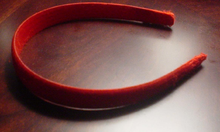- Headband
-
For other uses, see Headband (disambiguation)."Hairband" redirects here. For the "hair metal" genre use of "hair bands", see Glam metal.
A headband is a clothing accessory worn in the hair or around the forehead, usually to hold hair away from the face or eyes. Headbands generally consist of a loop of elastic material or a horseshoe-shaped piece of flexible plastic or metal. They come in assorted shapes and sizes and are used for both practical and fashion purposes.
Horseshoe-shaped headbands are sometimes called Alice bands after the headbands that Alice is often depicted wearing in Through the Looking-Glass.[1]
Contents
Background
The beginning of headbands started no later than the ancient Greeks who wore hair wreaths. The Greeks and Romans wore these pieces to very special occasions or an important event. Cultures such as the Etruscans and Romans started to decorate their wreaths with jewels made up of gold and silver. While wreaths are certainly a likely beginning of today's headbands, some believe that current day hair bands have slowly taken shape from scarves that were worn around the head or were modified from the band of hats that tied under the chin.
Fashion
 Rafael Nadal wearing green head band during a tennis match.
Rafael Nadal wearing green head band during a tennis match.
Over time the wearing of headbands has changed from being worn to special occasions and important events to more of a fashionable accessory. There are many kinds of headbands such as, leathered, plastic, metal, fabric, toothed and novelty. The leather headbands are usually glued onto a harder plastic headband, or they are hand-stitched. Plastic headbands, which are most common, can be wavy, straight or angled and come in many colors. Metal can also be used to form and support leather headbands. Metal-only headbands may be plain or decorated, sometimes with precious jewels. Fabric headbands are comfortable because they do not dig into the head. They usually have an elastic band, so that the headband forms to the head. The toothed headbands have comb-like teeth that are connected to the top part of the headband. Their teeth ensure that the hair stays in place. Novelty headbands can be used for holidays and may have decorations attached such as bunny ears, reindeer ears, Santa Claus hats and others. Deely boppers were a fad in 1982. Headbands are often are part of a larger fashion statement - they can be color coded and matched accordingly to one's outfit.
In Japanese culture, hachimaki headbands may symbolise determination or devotion.
Uses
"Sweatband" redirects here. For the Bootsy Collins album, see Sweat Band. For the component of a hat, see Sweatband (hat). Flag of Corsica shows a man wearing a headband.
Flag of Corsica shows a man wearing a headband.
Headbands, or sweatbands, are worn around the forehead during physical activity to absorb sweat and keep it from reaching the eyes. Sweatbands are often made of a continuous loop of terrycloth, as it is a particularly absorbent fabric. Folded bandanas, usually knotted behind the head, also serve this purpose. Headbands are usually used for sports but have not been popular since the late 1970s or early 1980s.
Some specialized headbands are designed to be worn covering the ears, to protect from cold temperatures and snow. These tend to be broader and of heavier fabric.These headbands are usually made from a heavier material such as neofleece, micro fleece, polyester and other materials. They are usually designed to draw sweat away from the skin and keep it dry and warm. These special headbands come in women's, men's and children's sizes. These headbands also come in many colors and are useful when doing winter activities such as skiing or snowboarding.
References
- ^ Chambers 21 Century Dictionary Allied Publishers
Categories:- Headgear
- 1980s fashion
- 2000s fashion
- 2010s fashion
Wikimedia Foundation. 2010.



